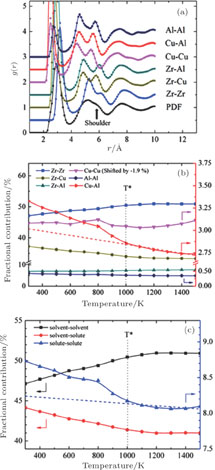Multiscale structures and phase transitions in metallic glasses: A scattering perspective
(color online) (a) PDF, g(r), and partial PDF of EAM MD-derived configurations are plotted. The position of the PDF shoulder has been indicated by the black arrow. (b) Development of the fractional contribution (adding up to 100%) of partial PDFs at the shoulder position. The partial PDFs were weighted by the x-ray scattering factors and compositions for each atomic pairs. The transition temperature, T
*, from the experimental data, is marked. As temperature decreases, the fraction of solute-solute atomic pairs, notably Cu–Al, increases. The dotted line is a linear fit of Cu–Al data for 

